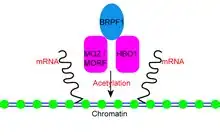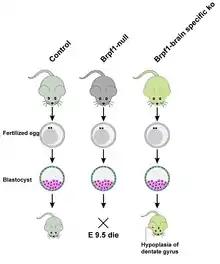Peregrin also known as bromodomain and PHD finger-containing protein 1 is a protein that in humans is encoded by the BRPF1 gene located on 3p26-p25. Peregrin is a multivalent chromatin regulator that recognizes different epigenetic marks and activates three histone acetyltransferases (Moz, Morf and Hbo1). BRPF1 contains two PHD fingers, one bromodomain and one chromo/Tudor-related Pro-Trp-Trp-Pro (PWWP) domain.
Function

Embryo development
Brpf1 gene is very conserved and has a critical role in different developmental processes.[2][3][4] Zebrafish BRPF1, which is coordinated by its particular set of PWWP domains, mediates Moz -dependent histone acetylation and maintains Hox genes expression throughout vertebrate development, hence determines the proper pharyngeal segmental identities.[6] Furthermore, Brpf1 may not only has significant role for maintaining the anterior-posterior axis of the craniofacial skeleton, but also the dorsal-ventral axis of the caudal skeleton.[7] Recent studies have shown that ablation of the mouse Brpf1 gene causes embryonic lethality at embryonic day 9.5.[3][4] Specifically, Brpf1 regulates placenta vascular formation, neural tube closure, primitive hematopoiesis and embryonic fibroblast proliferation.[3][4]
For the central nervous system, Brpf1 has high expression and is essential for the development of several important structures, including neocortex and dentate gyrus in the hippocampus.[3] Brpf1 is dynamically expressed during forebrain development, especially the hippocampal neurogenesis.[5] Brpf1 shares phenotypes with transcription factors Sox2, Tlx and Tbr2 in dentate gyrus development and has potential link to neural stem cells and progenitors.[5] Except for the forebrain, Brpf1 is also required for the proper patterning of the craniofacial cartilage, which is derived from neural crest cells that migrate from the hindbrain.[8]
Cancer development
Recently, Brpf1 was reported to play the tumor suppressor or oncogenic role in several malignant tumors, including leukemia, medulloblastoma and endometrial stromal sarcoma.[2][9][10][11] Brpf1 was considered a tumor suppressor gene because mutations in cancer cells appear to diminish the function of Brpf1[9][10] However, oncogenic role of Brpf1 is also possible in cancer. For example, Brpf1 can form a stable complex with Moz-Tif2, which could lead to the development of human acute myeloid leukemia (AML).[11] There is another Brpf1 related complex Brpf1–Ing5–Eaf6, which also plays a direct role in cancer.[2]
See also
References
- ↑ "Human PubMed Reference:". National Center for Biotechnology Information, U.S. National Library of Medicine.
- 1 2 3 4 Yang XJ (2015). "MOZ and MORF acetyltransferases: Molecular interaction, animal development and human disease". Biochimica et Biophysica Acta (BBA) - Molecular Cell Research. 1853 (8): 1818–26. doi:10.1016/j.bbamcr.2015.04.014. PMID 25920810.
- 1 2 3 4 5 You L, Chen L, Penney J, Miao D, Yang XJ (2014). "Expression atlas of the multivalent epigenetic regulator Brpf1 and its requirement for survival of mouse embryos". Epigenetics. 9 (6): 860–72. doi:10.4161/epi.28530. PMC 4065184. PMID 24646517.
- 1 2 3 4 You L, Yan K, Zou J, Zhao H, Bertos NR, Park M, Wang E, Yang XJ (2015). "The chromatin regulator Brpf1 regulates embryo development and cell proliferation". The Journal of Biological Chemistry. 290 (18): 11349–64. doi:10.1074/jbc.M115.643189. PMC 4416840. PMID 25773539.
- 1 2 3 You L, Yan K, Zou J, Zhou J, Zhao H, Bertos NR, Park M, Wang E, Yang XJ (2015). "The lysine acetyltransferase activator Brpf1 governs dentate gyrus development through neural stem cells and progenitors". PLOS Genetics. 11 (3): e1005034. doi:10.1371/journal.pgen.1005034. PMC 4355587. PMID 25757017.
- ↑ Laue K, Daujat S, Crump JG, Plaster N, Roehl HH, Kimmel CB, Schneider R, Hammerschmidt M (2008). "The multidomain protein Brpf1 binds histones and is required for Hox gene expression and segmental identity". Development. 135 (11): 1935–46. doi:10.1242/dev.017160. PMC 2919486. PMID 18469222.
- ↑ Hibiya K, Katsumoto T, Kondo T, Kitabayashi I, Kudo A (2009). "Brpf1, a subunit of the MOZ histone acetyl transferase complex, maintains expression of anterior and posterior Hox genes for proper patterning of craniofacial and caudal skeletons". Developmental Biology. 329 (2): 176–90. doi:10.1016/j.ydbio.2009.02.021. PMID 19254709.
- ↑ Yan K, You L, Degerny C, Ghorbani M, Liu X, Chen L, Li L, Miao D, Yang XJ (2016). "The Chromatin Regulator BRPF3 Preferentially Activates the HBO1 Acetyltransferase but Is Dispensable for Mouse Development and Survival". The Journal of Biological Chemistry. 291 (6): 2647–63. doi:10.1074/jbc.M115.703041. PMC 4742735. PMID 26677226.
- 1 2 Kool M, Jones DT, Jäger N, Northcott PA, Pugh TJ, Hovestadt V, et al. (2014). "Genome sequencing of SHH medulloblastoma predicts genotype-related response to smoothened inhibition". Cancer Cell. 25 (3): 393–405. doi:10.1016/j.ccr.2014.02.004. PMC 4493053. PMID 24651015.
- 1 2 Huether R, Dong L, Chen X, Wu G, Parker M, Wei L, et al. (2014). "The landscape of somatic mutations in epigenetic regulators across 1,000 paediatric cancer genomes". Nature Communications. 5: 3630. Bibcode:2014NatCo...5.3630H. doi:10.1038/ncomms4630. PMC 4119022. PMID 24710217.
- 1 2 Shima H, Yamagata K, Aikawa Y, Shino M, Koseki H, Shimada H, Kitabayashi I (2014). "Bromodomain-PHD finger protein 1 is critical for leukemogenesis associated with MOZ-TIF2 fusion". International Journal of Hematology. 99 (1): 21–31. doi:10.1007/s12185-013-1466-x. PMID 24258712. S2CID 207400403.
External links
- Human BRPF1 genome location and BRPF1 gene details page in the UCSC Genome Browser.
Further reading
- Klein BJ, Muthurajan UM, Lalonde ME, Gibson MD, Andrews FH, Hepler M, Machida S, Yan K, Kurumizaka H, Poirier MG, Côté J, Luger K, Kutateladze TG (Jan 2016). "Bivalent interaction of the PZP domain of BRPF1 with the nucleosome impacts chromatin dynamics and acetylation". Nucleic Acids Research. 44 (1): 472–84. doi:10.1093/nar/gkv1321. PMC 4705663. PMID 26626149.
- You L, Zou J, Zhao H, Bertos NR, Park M, Wang E, Yang XJ (Mar 2015). "Deficiency of the chromatin regulator BRPF1 causes abnormal brain development". The Journal of Biological Chemistry. 290 (11): 7114–29. doi:10.1074/jbc.M114.635250. PMC 4358132. PMID 25568313.
- Lubula MY, Eckenroth BE, Carlson S, Poplawski A, Chruszcz M, Glass KC (Nov 2014). "Structural insights into recognition of acetylated histone ligands by the BRPF1 bromodomain". FEBS Letters. 588 (21): 3844–54. doi:10.1016/j.febslet.2014.09.028. PMC 4252766. PMID 25281266.
- Carlson S, Glass KC (Nov 2014). "The MOZ histone acetyltransferase in epigenetic signaling and disease". Journal of Cellular Physiology. 229 (11): 1571–4. doi:10.1002/jcp.24617. PMC 4750494. PMID 24633655.
- Poplawski A, Hu K, Lee W, Natesan S, Peng D, Carlson S, Shi X, Balaz S, Markley JL, Glass KC (Apr 2014). "Molecular insights into the recognition of N-terminal histone modifications by the BRPF1 bromodomain". Journal of Molecular Biology. 426 (8): 1661–76. doi:10.1016/j.jmb.2013.12.007. PMC 3969779. PMID 24333487.
- Qin S, Jin L, Zhang J, Liu L, Ji P, Wu M, Wu J, Shi Y (Oct 2011). "Recognition of unmodified histone H3 by the first PHD finger of bromodomain-PHD finger protein 2 provides insights into the regulation of histone acetyltransferases monocytic leukemic zinc-finger protein (MOZ) and MOZ-related factor (MORF)". The Journal of Biological Chemistry. 286 (42): 36944–55. doi:10.1074/jbc.M111.244400. PMC 3196140. PMID 21880731.
- Mishima Y, Miyagi S, Saraya A, Negishi M, Endoh M, Endo TA, Toyoda T, Shinga J, Katsumoto T, Chiba T, Yamaguchi N, Kitabayashi I, Koseki H, Iwama A (Sep 2011). "The Hbo1-Brd1/Brpf2 complex is responsible for global acetylation of H3K14 and required for fetal liver erythropoiesis". Blood. 118 (9): 2443–53. doi:10.1182/blood-2011-01-331892. PMID 21753189.
- Vezzoli A, Bonadies N, Allen MD, Freund SM, Santiveri CM, Kvinlaug BT, Huntly BJ, Göttgens B, Bycroft M (May 2010). "Molecular basis of histone H3K36me3 recognition by the PWWP domain of Brpf1". Nature Structural & Molecular Biology. 17 (5): 617–9. doi:10.1038/nsmb.1797. PMID 20400950. S2CID 38082800.
- Hibiya K, Katsumoto T, Kondo T, Kitabayashi I, Kudo A (May 2009). "Brpf1, a subunit of the MOZ histone acetyl transferase complex, maintains expression of anterior and posterior Hox genes for proper patterning of craniofacial and caudal skeletons". Developmental Biology. 329 (2): 176–90. doi:10.1016/j.ydbio.2009.02.021. PMID 19254709.
- Ullah M, Pelletier N, Xiao L, Zhao SP, Wang K, Degerny C, Tahmasebi S, Cayrou C, Doyon Y, Goh SL, Champagne N, Côté J, Yang XJ (Nov 2008). "Molecular architecture of quartet MOZ/MORF histone acetyltransferase complexes". Molecular and Cellular Biology. 28 (22): 6828–43. doi:10.1128/MCB.01297-08. PMC 2573306. PMID 18794358.
- Poplawski A, Hu K, Lee W, Natesan S, Peng D, Carlson S, Shi X, Balaz S, Markley JL, Glass KC (Apr 2014). "Molecular insights into the recognition of N-terminal histone modifications by the BRPF1 bromodomain". Journal of Molecular Biology. 426 (8): 1661–76. doi:10.1016/j.jmb.2013.12.007. PMC 3969779. PMID 24333487.


